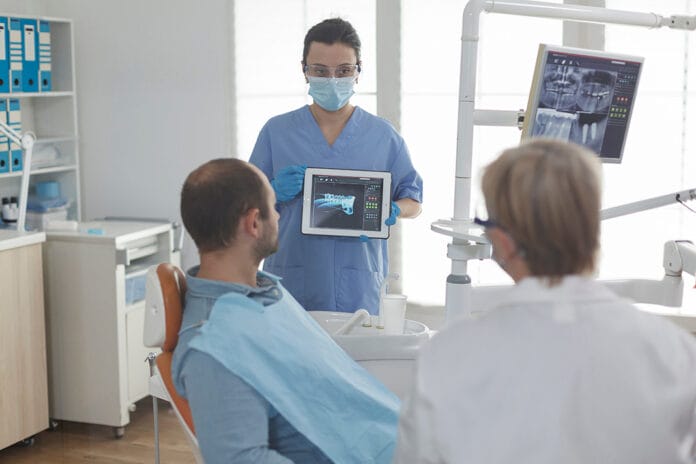An ounce of prevention is worth a pound of cure, and preventing disease is preferable to curing a disease. Prevention is the action of stopping something from happening or arising. Treatment is care given for an illness or injury. Even when illness is treated, one may not fully recover. Prevention saves money, time, pain, and inconveniences. Treatment costs money, time, and can cause a lot of pain and disruptions in life.
The difference of wording between the two actions provides the contrast of a lifestyle. Some words to describe prevention are avoidance, blocking, inhibiting, obstruction, stopping, prohibiting, thwarting, and deterrence. Some words to describe treatment are hospitalization, pharmaceuticals, therapy, surgery, healing, remedy, prescriptions, doctoring, and testing.
Prevention is more personal responsibility, choice, and control over health. Since a young age, the simple advice we’ve heard is to be healthy ‒ just exercise and eat healthy food. Dental professionals and many active dental patients know healthy habits prevent treatment for illness. The advantage and disadvantages are: We are in charge of our health every day and every meal, making a choice to be healthy or unhealthy to practice prevention over future treatment.
Dental Prevention vs. Treatment
Many dental conditions can be prevented to avoid treatment. Granted, some things just happen beyond our control, such as genetic factors. Periodontal disease, gingivitis, erosion, and caries can be prevented. The simplicity of prevention is brushing, interdental cleaning, and regular dental recalls. Diet, habits, lifestyle, interdental aids, electric toothbrushes, fluoride, and night guards are additional prevention techniques.
Purchasing dental dentifrices (i.e., fluoridated toothpaste) and interdental cleaning aids for a healthier periodontium (gingiva, periodontal ligament, cementum, and bone) and teeth will pay off to help keep the teeth and periodontium stable and healthy. On the other hand, paying for periodontal treatment, a root canal, or crown costs more, and sometimes these treatments can also cause different issues within the mouth and instability of the teeth. For example, restorations, root canal therapy, and crowns require the removal of tooth structure and may affect occlusion. Periodontitis causes the loss of the supporting periodontium, and treatment can only maintain not reverse the loss of periodontium, thus weakening the foundation of teeth.
Harm to the body ‒ whether through injury, illness, or accidents ‒ can cause suffering, deterioration, loss of function, pain, and a reduced capacity of normal functions. These conditions can cause fatal diseases, mental and physical traumas, severe stress, and depression that alters the ability to cope. When harm happens, the medical or dental provider works to relieve, reduce, or eliminate the ailment ‒ considered treatment, or in some cases, survival.
Money and time are going to go towards health no matter what ‒ either by prevention or treatment. Prevention is from years of taking care of health through a healthy diet, exercising, preventive tests, regular checkups, and avoidance of smoking, drugs, and excessive drinking. As someone ages, the medical costs spent for fixing years of bad habits can be costly.
In our healthcare system, more money is spent on alleviating, treating, and recovering from an illness than preventing it. According to the Centers for Disease Control and Prevention, chronic diseases are the leading cause of health care costs ‒ annually hitting close to $4 trillion. Untreated oral diseases cause over $45 billion in lost productivity and over two million visits to the emergency room.1
The different forms of treatment are:
- Cure: The successful elimination of the ailment or cause.
- Acute care: Symptoms are relieved in the hope of a cure.
- Rescue medicine: Emergency care from life-threatening ailments.
- Arresting disease: Stopping or slowing disease progression without eliminating or curing the ailment.
- Rehabilitation: The recovery process to gain function again.
Prevention occurs when an illness, impairment, or risk factors for disease are reduced and when the pre-symptomatic disease is detected early and is cured or mitigated. Prevention prevents the onset of disease or detects it in a curable stage before it becomes symptomatic.
The forms of prevention are considered as:
Primary prevention: Prevents disease or disability from starting with vaccines, immunizations, healthy eating, and exercising.
Secondary prevention: Intervenes in detecting and arresting disease or disability in early asymptomatic stages with screenings.
Tertiary prevention: Inhibits already symptomatic illness from progressing, which can be a form of treatment.
Primordial prevention: Eliminates risk factors, precursors, and genetic counseling to avoid genetic conditions.
Prevention Messaging
Even though preventative education can be simple, well-defined statements, patients often dismiss preventable opportunities. Patients can perceive the message nonchalantly as they have repeatedly heard the same “lecture.”
Dental professionals say, “brush and floss,” which are very simple instructions to anyone who has been to the dental office. What is really meant is that if you don’t brush or clean interdentally, there’s a higher risk of oral infection, active disease, permanent destruction of tissue and bone, loose and missing teeth with the end result of tooth or teeth extractions, which may lead to the need for costly implants and/or dentures.
When the dermatologist states, “Wear sunscreen,” the statement is more than the two words. The short version is basically “just put sunscreen on.” The longer version is to wear sunscreen to “protect your skin from UV rays, premature aging, skin discoloration, sunburns, and risk of cancer.” The cancer treatment is the removal of lesions and, if not in a timely manner, it moves into the lymph nodes and can metastasize and cause death. Simply wearing sunscreen can keep you out of the dermatology office for invasive treatment and alive.
The physician will advise to “lose weight,” a very simple instruction. What is meant is that if you gain weight, are overweight or obese, you have an increased chance of inflammatory diseases, colds, cases of flu, diabetes, high blood pressure, high cholesterol, cancer, stroke, and heart attack. All of the conditions can increase doctor visits and, more importantly, promote premature deaths.
Patients offer many excuses about why they don’t ‒ unconsciously or consciously ‒ want to prevent issues, maintain their oral health, and save their teeth. They “forget.” Well, it’s easy to make a note or use the alarm on the cell phone for a reminder, especially since, for instance, they don’t forget to eat and shower.
They “don’t have time.” However, they can use social media, play games, or watch TV for four minutes per day, plus a touch more time for interdental cleaning. They “run out of floss” ‒ but never food, cigarettes, or alcohol. When they replenish those items, interdental cleaning aids are in the same building.
They are “too tired.” However, patients can brush and clean interdentally when it’s convenient, perhaps even flossing while watching TV, well before they get too tired. It “takes too long.” Four and a half minutes a day is worth maintaining oral health and keeping the teeth, and it’s divided into two sessions daily.
Placing a Priority on Prevention
The multiple excuses show where their priorities are. They’re not motivated enough to take care of themselves, but they have no reservations about taking time for treatment. It comes down to priorities of health and being health responsible.
Nightguards are challenging preventive steps for patient acceptance. Dental professionals seem to need to “convince” patients to buy and then use night guards. When a tooth fractures from grinding or clenching, patients are more accepting of paying for a crown and even a root canal. However, if they purchased and used a night guard which protects multiple teeth, it would be cheaper in the long run.
Once the patient is forced to act, most of the time, they do (as opposed to no treatment) what we call a “watch.” For example, a tooth with a fracture may have been a “watch” prior to the tooth breaking and was perhaps considered treatment that may be needed. Most people would rather wait for that “some point.” Prevention is keeping the teeth strong and in one piece instead of drilling into them.
Periodontal disease isn’t just bleeding and inflammation of the gingiva. The health debt progresses to tooth loss and prominent inflammatory systemic conditions. Instead of treating one issue now, it branches out to multiple treatment possibilities, which can be systemic. There’s a possible bridge, partial denture, or implant needed with tooth loss. Once diseased, not only the physical cost of permanent damage and stress can occur, but also the mental exhaustion of not feeling well may occur.
Many insurance companies have the same attitude. They won’t pay for fluoride or nightguards to save teeth, but they will pay more for restorative treatment, crowns, and extractions. Prevention is taking care of yourself and making your own choices, despite what insurance covers or not.
Dental patients are in charge of their health. When someone else is needed to treat a health issue, you’re dependent on their knowledge, experience, and their choices in what is best for your health. When you have to be treated, health freedom is lost as you need someone to provide regular tests or fill prescriptions just to function in daily activities or even survive.
Prevention and the maintenance of health keep patients feeling good and viable for daily activities. Money and time are saved from multiple visits, missing work to attend medical or dental visits, gas, and copays. Keeping up on recovery or lifesaving procedures such as physical therapy or follow-up appointments along with the saddled monthly cost of medication all adds up mentally and financially. Another aspect of not preventing disease is when insurance is lost, and a patient can’t afford doctor visits, tests, lab work, or prescription refills that are needed to live.
Factors Influencing Professional Care
Some people do not seek professional health care, whether it’s for preventable modalities or seeking treatment for a recovered quality of life. The reasons why may include:
Low perceived need ‒ Low perceived need is when the belief of seeking care is unnecessary. The thought is that a condition will improve with time, or the body will naturally heal it, as well as the justification that “it’s not that bad.” The most popular thought is that “If it’s not broken, don’t fix it.”2
Affective concerns ‒ Fear, anxiety, and embarrassment are moods that influence health care. It’s the concern of hearing bad news that a tooth is worse than expected. It’s the anxiety about dental needles. It’s the embarrassment about the condition of their mouth.2
Negative outcomes ‒ Many people believe they will not have good outcomes. They believe they’ll become worse, won’t follow recommendations, do not want to take prescribed medications, and dislikes or don’t believe professional recommendations.2
Personality ‒ Some instinctive traits behind avoiding preventable measures could be laziness, procrastination, stubbornness, and forgetfulness.2
Providers ‒ Dealing with providers can be difficult and perceived as a lack of caring, poor communication, and not listening. Providers may seem arrogant or make the patient feel stupid or feel like they’re being lectured. It can be a general mistrust of doctors when a patient is rushed through an appointment, and providers just don’t seem to care.2
Barriers ‒ Patients will think they don’t have time or are too busy to seek treatment. Even clinic hours are seen as inconvenient. They don’t want to take time off work, or the drive is too far. Depression or anxiety also hinders treatment. The financial costs of copays, deductibles, procedures, or lack of insurance are concerns.2
Generally, we are all born with good health; it can be our lifestyles, habits, choices, and diet that make us unhealthy. Many situations outside of hereditary health risks are preventable, and we can only prevent the best we can to keep quality of life and prolong our life and maintain oral health. But it’s worth the try.
Now Check Out the Peer-Reviewed, Self-Study CE Courses from Today’s RDH!
Listen to the Today’s RDH Dental Hygiene Podcast Below:
References
- Cost-effectiveness of Chronic Disease Interventions. (2021, April 28.) Centers for Disease Control and Prevention. https://www.cdc.gov/chronicdisease/programs-impact/pop/index.htm
- Taber, J.M., Leyva, B., Persokie, A. Why do people avoid medical care? A qualitative study using national data. Journal of General Internal Medicine. 2015; 30(3): 290-297. https://www.ncbi.nlm.nih.gov/pmc/articles/PMC4351276/











